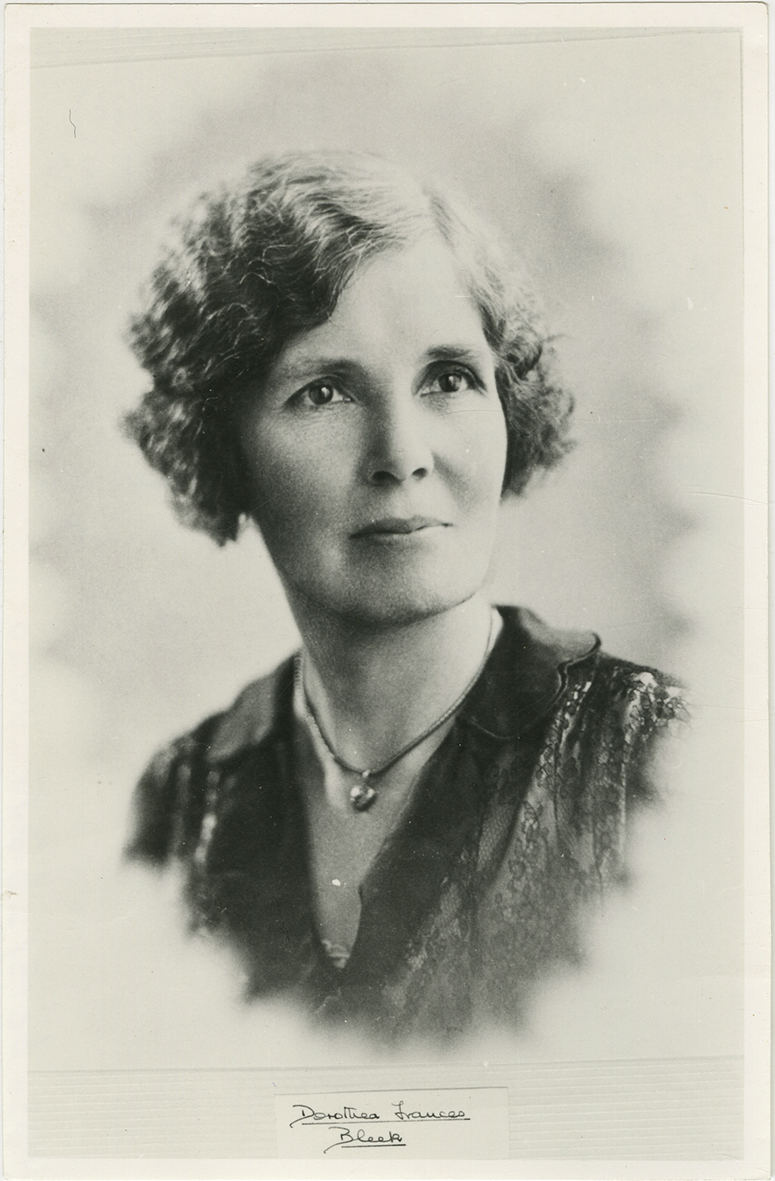
Dorothea Bleek was born in Mowbray, Cape Town, on 26 March 1873. She was the sixth and second-youngest child of Wilhelm and Jemima Bleek and Jemima Bleek. Dorothea (also known as Doris) attended school in Switzerland and Germany after her mother took the family to live in Europe in 1883. She trained as a teacher at Berlin University and studied at the School of Oriental and African Languages in London, though did not take a degree, where she developed her interest in African languages. She became a recognised figure in anthropological and linguistic fields in Europe in her own right.
Dorothea Bleek returned to South Africa in 1904 and worked as a teacher at Rocklands Girls’ High School in Cradock until 1907. She went on field trips with a colleague, Helen Tongue, who made copies of rock paintings, and travelled to London when the paintings were exhibited there in 1908. In 1909 some of the paintings were published with notes by Dorothea Bleek and her sister Edith in which they reminisced about life in Cape Town and the ǀxam and ǃkun who had lived with them.
On her return from London in 1908, Dorothea devoted the rest of her life to studying hunter-gatherer languages. She had been trained in translation and methods of research by Lucy Lloyd and, apparently, taught to speak both ǀxam and ǃkun (presumably the instruction began in the 1870s and 1880s and continued during the time Lucy stayed with her sister Jemima in Europe and after Lucy’s return to Cape Town).
Dorothea visited the Northern Cape in 1910 and 1911, going to Prieska and Kenhardt in an attempt to locate the descendants of those interviewed by her father and aunt years earlier. She was accompanied on this trip by staff of the South African Museum, who took photographs and made plaster casts of ǀxam descendants for display in the museum, later installed as the famous and controversial ‘Bushman diorama’.
Dorothea assisted Lucy Lloyd in preparing Specimens of Bushman Folklore for publication. She edited and published a considerable amount of her father’s and aunt’s research on the ǀxam after Lucy’s death, in the journal Bantu Studies. She went on many expeditions to study rock art and hunter-gatherer languages, to places such as the Kalahari, Tanganyika and Angola. Apart from recording genealogies, vocabulary, narratives and rock art, she also took photographs of people she met, illustrating the condition of their lives. Sadly, she had little skill as a photographer and many of them cropped off heads and feet or were wildly out of focus. Her interest in anatomy and race, however, is at times rather disturbingly revealed in images of naked people with a pile of their clothes at their feet.
Not nearly as methodical as her aunt Lucy, Dorothea nevertheless kept a series of 32 notebooks between 1910 and 1930, valuable for their documentation of her travels and her notes on dialects, vocabularies, genealogies and related information. She also made recordings of languages spoken and music on wax phonograph cylinders (now in the collection of the South African Museum and the University of Cape Town), some of which have been recently salvaged and digitally translated, though all in poor condition.
In 1920, 1921 and 1922 Dorothea and staff from the South African Museum travelled to what is now Botswana, to study the Naron (Nharo) and their language. (She later went again on her own, accompanied by an interpreter.) This study was published in 1928. In 1925 she undertook a journey through Angola travelling with botanist Mary A Pocock on foot, in dugout canoes, and at times, by train, recoding snippets of conversations in ǃkun and later compiling a ǃkun lexicon in hundreds of slips. Mary Pocock’s diaries have been published as "Bushmen, botany and baking bread".
In 1929 Dorothea Bleek arranged for a publication of the George Stow drawings and paintings purchased by Lucy Lloyd, in a volume entitled Rock Paintings in South Africa. She employed artists to copy rock paintings throughout the 1930s. Some were published in More Rock Paintings in South Africa. She also published a more popular version of some |kaggen stories entitled The Mantis and His Friends (1924). Between 1931 and 1936 she prepared ǀxam texts selected by Lucy Lloyd for publication. These appeared as nine papers in Bantu Studies, with titles including ‘Special Speech of Animals and Moon Used by ǀXam Bushmen’, as well as a written piece concerning photographs taken during her 1910–11 trip to the Northern Cape. A Bushman Dictionary was published posthumously in 1956, incorporating the lexicon worked on by Wilhelm Bleek and Lucy Lloyd, and the word lists she collection.
Dorothea Bleek was honorary reader in Bushman languages at the University of Cape Town from 1923 to 1948, when she became well known for her division of hunter-gatherer languages into Northern, Central and Southern groups, and during this time she donated much of the material that now constitutes the Bleek and Lloyd archive at UCT and Iziko South African Museum. She died on 27 June 1948 at The Garth in Plumstead, Cape Town, at the age of 75.
Cite: Skotnes, P. 2025. Dorothea Bleek. in ǃkhwe-ta ǃxōë Digital Bleek and Lloyd. Centre for Curating the Archive: https://digitalbleeklloyd.uct.ac.za/df-bleek.html
Note: BC151 J2.1 to J4.20, photographs taken at Van Wyksvlei, Prieska, Gordonia, Nossop, Lake Chrissie, Bechuanaland, Angola and elsewhere in the Kalahari by Dorothea Bleek were destroyed in the fire of 2021 at UCT. Some of these photographs can be found here.